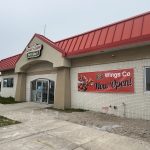Taking back Milwaukee – one foreclosure at a time
There are nearly 2,200 foreclosed homes in Milwaukee according to city records; about 90 of them are in the roughly one square mile that makes up the Lindsay Heights neighborhood on Milwaukee’s north side. However, one area resident is working to change that.
Joe Dahl, a 30-year-old MBA student at UW-Milwaukee’s Lubar School of Business, has been investing in real estate for 10 years. Recently, he’s begun buying and rehabbing some of the foreclosed properties in his neighborhood.
Dahl says he does it not only because it’s good for the community, but because it’s good business for his company, Milwaukee Metro Management, which also manages properties owned by other investors.
“Obviously, I don’t buy these houses to lose money,” said Dahl while finishing work on his latest purchase, a 12-year-old single family house near North Avenue. “But I’m in a position to do something. I don’t have to watch and wait.”
Lindsay Heights –which runs along Interstate 43 on the east to 20th Street on the west, and south to Walnut — has seen more than its share of vacant homes thanks to the foreclosure crisis. Vacant properties tend to attract thieves, vandals, and squatters and provide cover for drug use and other illicit activities. According to city data from 2010, the area reported higher-than-average occurrences of burglary, arson and criminal damage to property.
“This place is only 12 years old, and I had to replace the roof,” said Dahl. The walls had also been badly damaged by vandals, and much of the copper plumbing had been stolen. In addition to the purchase price, Dahl says he’s spent about $30,000 repairing the house. For the first time, he’s participating in the City of Milwaukee’s Neighborhood Stabilization Program (NSP), which will reimburse him for half of that sum.
“Our top priority is to return as many people as possible to homeowner-occupied housing,” said Suzanne Dennik, who contracts with the city to administer the program. “But we also have a program for investors.”

Empty homes often invite an unwanted element into neighborhoods. Photo via Milwaukee Metro Managment website.
Dennik said the vetting process for investors requires a track record as a responsible landlord with zero code violations on current properties. Inexperienced investors must complete a landlord training class, offered by the Department of Neighborhood Services, in order to be eligible for NSP funds.
NSP loans can only be used on foreclosed properties, and investors must sign binding covenants which stipulate affordable rents and income guidelines for renters for periods of five or 10 years, depending on the amount of the loan. The loans can be forgiven once the covenant has been completed.
Dahl said the conditions attached to the funding don’t interfere with his business plan.
“Honestly, I’d rather have a tenant who pays, say, $900 a month and is stable, someone who’s an asset, than someone who’d pay $1200 but causes problems.” Dahl also said that while he’s sold houses during his investment career, he’s never made short-term investments in real estate.
“I’m not a flipper — I don’t buy anything I don’t want to own for the long term.”
 He was initially leery of working with the city, he says, in part because of the time it would add to the project.
He was initially leery of working with the city, he says, in part because of the time it would add to the project.
“They keep saying I’m moving too fast,” Dahl said of the city inspectors monitoring his progress, “but I can’t have this place sitting here empty. What if it gets vandalized again?” He pointed out that the house sits across the street from a vacant commercial property, and said thieves could get in and take a hot water heater in as little as 10 minutes.
“Who’s watching at 3 a.m.?”
Dahl started work on this property in late November, and will be finished in time for tenants to move in Feb. 1.
Obie Blunt, a plumber who works for Milwaukee Metro Management, also rents one of Dahl’s houses just across the back yard from this latest purchase.
“I’ve been here about two years,” said Blunt. “I had been living around the corner, but I love it here because I’ve got a lot of space, and I need that because I kind of have a big family.”
Blunt recently had to call the fire department when he smelled smoke coming from the vacant foreclosed property next door after squatters started a fire. The bank-owned property isn’t technically on the market yet, and the second-story windows had to be removed to put out the fire. Ground-floor entrances are covered by sheets of dark green DNS plywood.
Dahl counts himself lucky that Blunt noticed the fire before it could spread, and that he hopes the property doesn’t sit empty much longer.
“If it’s still vacant in spring,” he says, “I guarantee somebody else will get in there.”
After he completes his MBA this spring, Dahl plans to continue working for himself, and to continue investing in Lindsay Heights.
“I live here, I’m vested here, and I don’t plan on moving anytime soon.”

















Very informative and nice article. I wish Milwaukee had more investors like Joe willing to take the risks to make Milwaukee a better place for us all.